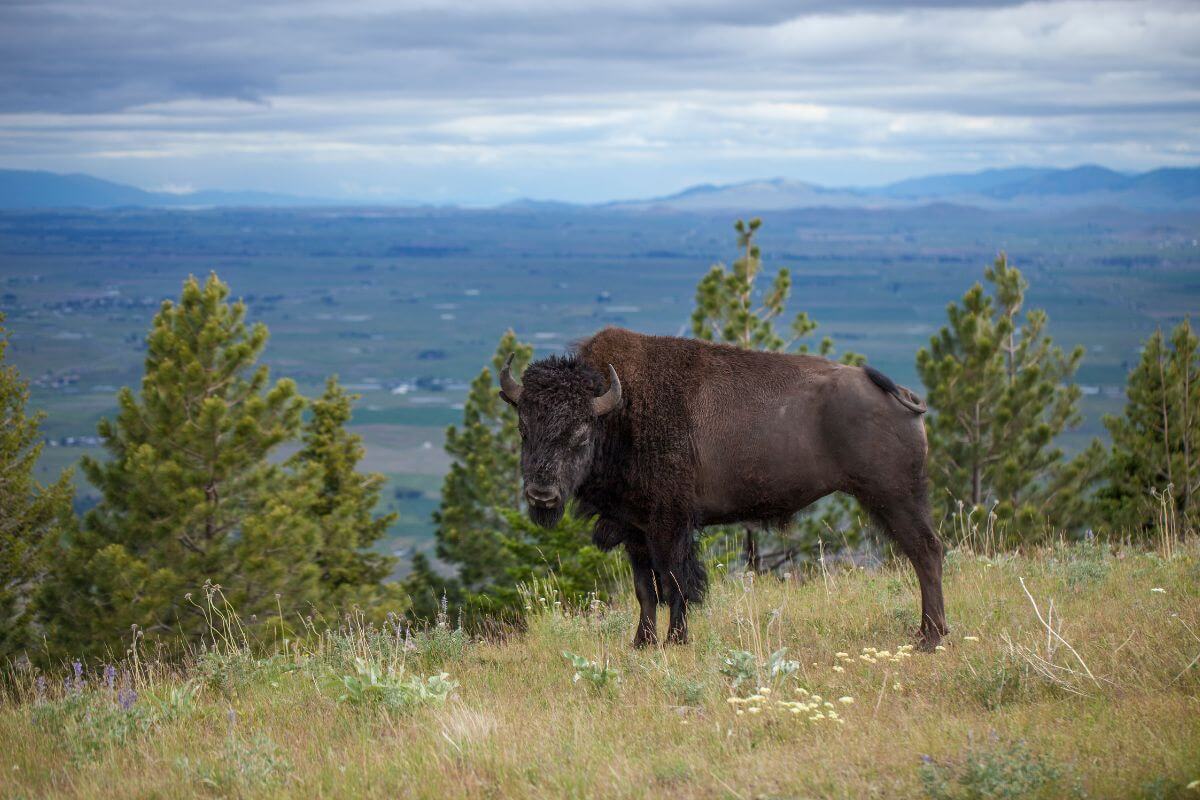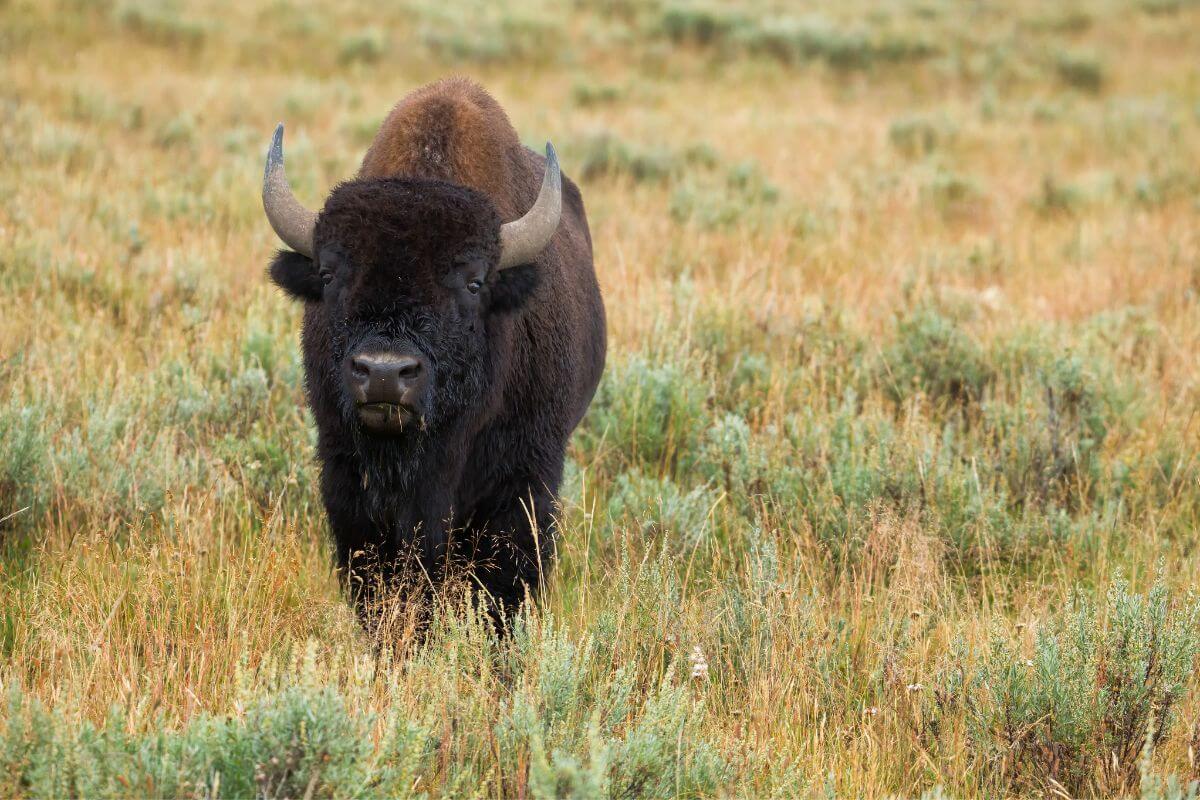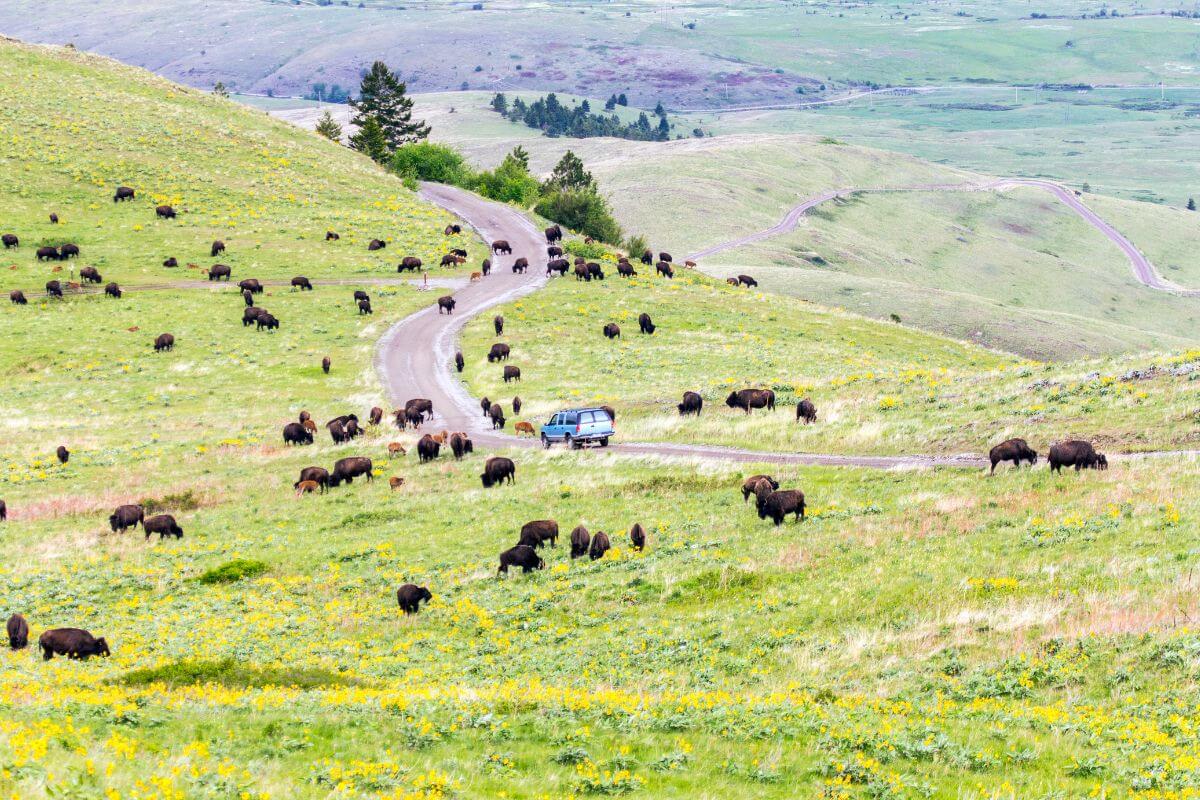Are you planning a visit to the Bison Range Wildlife Refuge in Montana? This refuge within the Flathead Indian Reservation is a sanctuary for nature and history lovers alike. It’s a piece of land dedicated to preserving the past and protecting the future of wildlife in Montana.
We’ll take you through the Bison Range’s history from its founding in 1908 to the present day, now under the federal trust ownership of the Confederated Salish and Kootenai Tribes (CSKT). You’ll learn about this land’s key role in bison conservation and how it has preserved a piece of history.
- Related article: Discover Wildlife Refuges in Montana
Curious about what you can do at the Bison Range? We’ll guide you through must-see activities, including scenic drives with breathtaking views and educational field trips that deepen your understanding of conservation.
6 Key Takeaways on the Bison Range Wildlife Refuge
- The Bison Range was founded in 1908 and is one of the oldest wildlife refuges in the United States.
- The Bison Range’s history is marked by the resilience of the bison population, which grew from a few orphaned calves to a herd of 500. The initial herd grew into a bigger bison herd called the “Pablo-Allard herd.”
- As of 2022, the Confederated Salish and Kootenai Tribes (CSKT) Natural Resource employees fully own and manage the Bison Range as a wildlife refuge.
- The Bison Range covers 18,766 acres and is located at the center of the 1,250,000-acre Flathead Indian Reservation.
- Visitors can enjoy various activities at the Bison Range, from scenic drives to educational tours.
- The Bison Range is a pay-to-enter area with specific policies such as no hunting allowed.
History of the Bison Range Wildlife Refuge
The Bison Range Wildlife Refuge has a long and interesting history that spans over a century. Over the years, the refuge has provided a safe place for bison and other native species. Let’s explore the history that has shaped this important part of American wildlife heritage.
When Was the Bison Range Founded and How Has It Changed Over the Years?

The Bison Range Wildlife Refuge was founded in 1908 and is one of the oldest wildlife refuges in the United States. Formerly the National Bison Range, this sanctuary was created within the Flathead Indian Reservation by the U.S. Federal Government.
It’s important to note that the land for the Bison Range was taken without the consent of the Confederated Salish and Kootenai Tribes (CSKT). This land now houses bison, direct descendants of the free-ranging Reservation herd started by Tribal members in the 1800s when the plains bison were near extinction.
The Bison Range has transformed over the years, especially with the passing of Public Law 116-260. This law returned the range to federal trust ownership under the CSKT, making it unique among wildlife refuges. Now, the CSKT’s award-winning natural resource managers oversee the area.
CSKT Natural Resource employees fully owned and managed the Bison Range as a wildlife refuge in 2022. The land will continue to be owned by the federal government but in trust for the Confederated Salish and Kootenai Tribes.
Today, the Bison Range spans 19,000 acres of natural grassland and is home to about 500 American bison. It also houses diverse wildlife, including birds, deer, elk, and sheep. It highlights the importance of respecting Indigenous contributions to caring for the environment.
What Is the Bison Range’s Cultural Impact on Montana?

The Bison Range Wildlife Refuge holds a special place in the hearts of Montana’s Native Americans. In the 1870s, a Ql̓ispé (also known as the Kalispel or Pend d’Oreille) man named Little Falcon Robe brought orphaned bison calves across the Continental Divide to the Flathead Indian Reservation.
This event marked the start of a new period focused on survival and protection. It was an important time because the large-scale killing of bison had nearly wiped them out. The effort to establish a herd was a sign of hope for the survival of these magnificent animals.
The CSKT tribes raised this initial herd of bison that tribal members Michel Pablo and Charles Allard later took over. The herd then became the “Pablo-Allard herd,” the world’s largest herd of plains bison by the late 1800s. This successful bison community represented the Indian people’s pride and strong connection to the land.
One particular bison from this renowned herd is a white bison known as Big Medicine, born at the Bison Range. Big Medicine is a descendant of the Pablo-Allard herd, a spiritual symbol highly respected by Tribal members.
CSKT tribe members visited this special bison numerous times from 1933 to 1959. Its presence highlights the enduring connection between the Indian people and the bison at the Bison Range.
What Are the Conservation Efforts of the Bison Range?
The Bison Range shows the CSKT tribes’ dedication to preserving nature. Their commitment shines through in various ways, making the refuge a beacon of conservation. With their dedicated staff and extensive experience in wildlife management, they have made the range a thriving hub of biodiversity.
The CSKT tribes have a long history of being exceptional caretakers of the environment. They adhere to the EPA’s strictest air quality standards, showcasing their commitment to a healthy ecosystem. The work of the Tribes’ Natural Resources Department further underscores this dedication.
The key conservation efforts at the Bison Range include:
- Establishment of Tribal Wilderness – The CSKT tribes were the first to create a Tribal Wilderness, dedicating vast acres to conserving grizzly bears, elk, and bighorn sheep.
- Repopulation of Endangered Species – The skies and waters of the refuge now see the graceful flights of populations of trumpeter swans and peregrine falcons thanks to the CSKT tribe’s efforts. Their next mission? Restoring the habitat for leopard frogs.
- Model Restoration – The restoration of the Jocko River by the Tribes and their efforts in acquiring and restoring fish and wildlife habitats have become national examples of excellence.
Perhaps their most striking effort is the story of the bison. CSKT tribal members were key in rescuing the bison from extinction, ensuring they roamed free and multiplied. Preserving the bison spans generations and is a core part of the Tribes’ ongoing commitment to conservation.
What to Expect on Your Visit to the Bison Range
Ready to take on a journey to the Bison Range Wildlife Refuge? Let’s prepare you for an unforgettable experience with insights on what to expect.
As you plan your visit, remember that the refuge offers a slice of untouched nature where you can witness bison roaming freely.
1. Where Is the Bison Range Wildlife Refuge?
The Bison Range sits at the heart of the Flathead Indian Reservation in Montana. It’s a significant piece of a 1,250,000-acre puzzle, with the Bison Range itself spanning 18,766 acres. What’s fascinating is that more than half of this range is neighbors with Indian trust land and waterways.
Getting to the refuge is like a walk in the park if you’re in Kalispell or Montana, just a bit longer. Here’s how you can get to the Bison Range by car from Missoula:
- Drive north on U.S. Highway 93 to Ravalli, then a scenic turn west onto State Highway 200.
- After about 5 miles (8 km), you’ll hit the junction of Highways 200 and 212.
- Hang a right (north) and drive another 5 miles (8 km). Boom, you’re at the entrance in Moiese.
Follow these directions to the Bison Range if you’re driving from Kalispell:
- Head south on U.S. Highway 93 or State Highway 35 to Polson, then stick to Highway 93 through Pablo and Ronan until you meet State Highway 212.
- A 12-mile (19-km) drive (enjoy the views as you pass through Charlo) gets you to the entrance at Moiese.
Are you coming from the west? Take Highway 200 through Dixon to the junction of Highways 200 and 212. Turn left (north) and drive about 5 miles (8 km) to the entrance.
For those who like their directions straight up, the address you’re aiming for is 58355 Bison Range Rd, Moiese, MT 59824. Remember, some gravel roads are in the range, but the journey is part of the experience.
2. What Activities Can You Do at the Bison Range?

The Bison Range Wildlife Refuge is a place to see various wildlife species and fully engage yourself in nature. Here are the top activities you can enjoy at the range:
- Scenic Drives – The Bison Range offers two stunning drives. The Red Sleep Drive, open during summer, takes you on a 2-hour, 19-mile (31-km) journey over Red Sleep Mountain. It’s a chance to see breathtaking valley views and look for bears, birds, and other creatures. The Prairie Drive, open year-round, is a 14-mile (23-km) route along Mission Creek, perfect for spotting bison, elk, and more.
- Fishing – You’re in luck if you love fishing. Fishing is allowed at the Bison Range, but make sure you have the right licenses and follow all the rules. You need a valid CSKT Conservation License, CSKT Fishing License, and Bison Range Day/Annual pass.
- Field Trips & Tours – Educational visits are welcome, with tailored activities for students of all ages. Field trips run from Monday to Thursday, with additional days depending on staff availability. They’re a great opportunity to learn about the ecosystem and local culture.
Here’s what to expect from a field trip or tour at the Bison Range:
- Museum Tour – Take a 40-minute tour to learn about the cultural and traditional significance of the Bison Range and the Confederated Salish and Kootenai Tribes (CSKT).
- Pond Walk – Discover the secrets of the pond ecosystem through a guided walk, presentation, and even an insect identification activity.
- Prairie Walk – Stroll along the information trail near the Visitor Center to understand more about the grassland habitats.
- Animal Activities – This hands-on experience is perfect for budding naturalists. It includes examining tracks, bones, and pelts, along with interactive games and presentations.
- Native Games – Kids can get active with traditional native games, weather and availability permitting.
Each activity offers a unique way to connect with nature and learn about this special place.
3. What Are the Bison Range’s Visiting Hours and Fees?
The Bison Range opens its gates as a pay-to-enter, fee-use area. This means you must pay to enjoy the stunning wildlife and landscapes. But remember, having a CSKT Conservation Permit doesn’t get you in — you must purchase an entrance pass.
Here are the visiting hours for the Bison Range:
| Facility | Winter Hours (Nov-April) | Summer Hours (May-Oct) |
|---|---|---|
| Gate | 8 am – 6 pm | 7 am – 8 pm |
| Visitors Center | 8 am – 5 pm | 7 am – 7 pm (Last pass sold at 6:30 pm) |
| Red Sleep Drive | CLOSED | 7 am – 8 pm (Last car allowed at 6 pm) |
| Buffalo Prairie Drive | 8 am – 6 pm (Last pass sold at 5 pm) | 7 am – 8 pm (Last car allowed in at 7 pm) |
Note these dates when the Bison Range is closed:
- Thanksgiving – CLOSED
- Christmas Eve (Dec 24th) – 8 am – 2 pm
- Christmas Day (Dec 25th) – CLOSED
- New Year’s Day (Jan 1st) – CLOSED
Remember, safety and weather concerns could lead to additional closures. It’s wise to call ahead for updates before you head out.
Here are the entrance fees for the Bison Range:
| Pass Type | Price |
|---|---|
| Day Pass REG | $20.00 per vehicle |
| Day Pass VAN | $35.00 per vehicle (10+ seats) |
| Commercial Day Pass | $60.00 per vehicle |
| Annual Pass | $60.00 per vehicle (expires at the end of the calendar year) |
| Educational Annual Pass | $40 Class A (vehicles of any size) $35 Class B (vehicles with 15 seats or less) |
| CSKT Tribal Members | FREE |
The Educational Annual Pass is a special deal for organizations that look after or educate groups. It covers all vehicles of the specified class or lower for a year.
If you’re driving a company-owned vehicle for a tour or part of a paid service, ensure you get the right pass. The driver is responsible for having the correct pass, and not doing so is a breach of the rules.
4. What Are the Bison Range’s Policies?
Be aware of specific policies designed to protect the natural habitat and ensure everyone’s safety before visiting the Bison Range. Here’s what you need to know:
- Prohibited Activities – Hunting, crossbows, bows, arrows, and air guns are prohibited here. The same rule applies to firearms, fireworks, and any other explosive devices. It is also not allowed to disturb, injure, spear, poison, destroy, or collect any plant or animal (including parts like antlers).
- Getting Around – Off-road driving is off-limits, except on designated open roads. You can walk around, but only on designated trails, picnic areas, sanitation stations, and fishing spots. It’s a good idea to stick close to your vehicle for your safety.
- On the Road Rules – If your vehicle is over 30 feet long or if you’re towing a trailer, they are not allowed on Red Sleep or Prairie Drive. The same goes for motorcycles, ATVs, and bicycles.
- Animal Watching Etiquette – Stopping to admire the animals is allowed if you don’t block the road. Remember, the animals are wild. So, keep your distance — at least 100 yards (91 m) from bears, wolves, and mountain lions, and at least 25 yards (23 m) from everything else, including the impressive bison.
- Pets Are Welcome, on Leash – You can bring your furry friends, but they must be on a leash and under control. You will also need to clean up after them to show respect for the area.
- High-Flying Cameras – Drones are a cool gadget, but not here unless you have special permission.
If you have any questions or need more info, feel free to reach out:
- Bison Range – (406) 644-2211
- CSKT Natural Resources Department – (406) 883-2888
- Email – csktbisonrange@gmail.com
These policies ensure everyone has a safe and enjoyable visit while protecting the wildlife and their home.
Bison Range Wildlife Refuge Final Thoughts

The Bison Range is a timeless tribute to conservation and cultural stewardship. Its story highlights the incredible journey of the American bison and the dedicated efforts to protect not just a species but an idea — that nature should be cherished and preserved.
The refuge’s impact goes beyond its boundaries, reaching into the hearts of those who call Montana home and reminding us all of the importance of our natural heritage. It’s a place where the bison roam free, thanks to the unwavering commitment of the Confederated Salish and Kootenai Tribes.
Visiting the Bison Range is like traveling through time and learning about conservation’s future. It’s a special experience that combines nature, history, and culture.
Bison Range Wildlife Refuge FAQs
1. Can You Visit the Bison Range?
The Bison Range is open to the public and offers opportunities for wildlife viewing, photography, and educational programs. Visitors can drive the scenic road through the refuge, where they may encounter abundant wildlife species in their natural habitat.
2. How Much Does It Cost to Go to the Bison Range?
The entrance fee for the Bison Range in Montana is $20 per vehicle for a day pass, while an annual pass costs $60.
3. What Are Some Interesting Facts About the National Bison Range Wildlife Refuge?
The National Bison Range Wildlife Refuge, established in 1908 by President Theodore Roosevelt, is one of the oldest wildlife refuges in the U.S., dedicated to conserving the American bison. Spanning diverse landscapes, including grasslands and mountains, it shelters bison and a variety of amazing animals such as elk, deer, and numerous bird species.
4. Who Owns the Bison Range?
Through Public Law 116-260, Congress has restored the Bison Range to federal trust ownership for the Confederated Salish and Kootenai Tribes (CSKT), allowing them to assume stewardship of the Range’s buffalo, wildlife, and land.
5. How Long Does It Take to Drive the Bison Range?
Two self-guided drives at the Bison Range provide visitors with up-close views of the bison. The Red Sleep Drive is a longer route, taking approximately two hours one way, while the Buffalo Prairie Drive is a shorter option, taking about an hour to complete.
Don’t miss out on the adventure! Continue reading to uncover more about Montana:
- Visit Benton Lake Wildlife Refuge
- Explore Black Coulee Wildlife Refuge
- Bowdoin Wildlife Sanctuary Guide
- Facts About the Charles M Russell Wildlife Refuge

